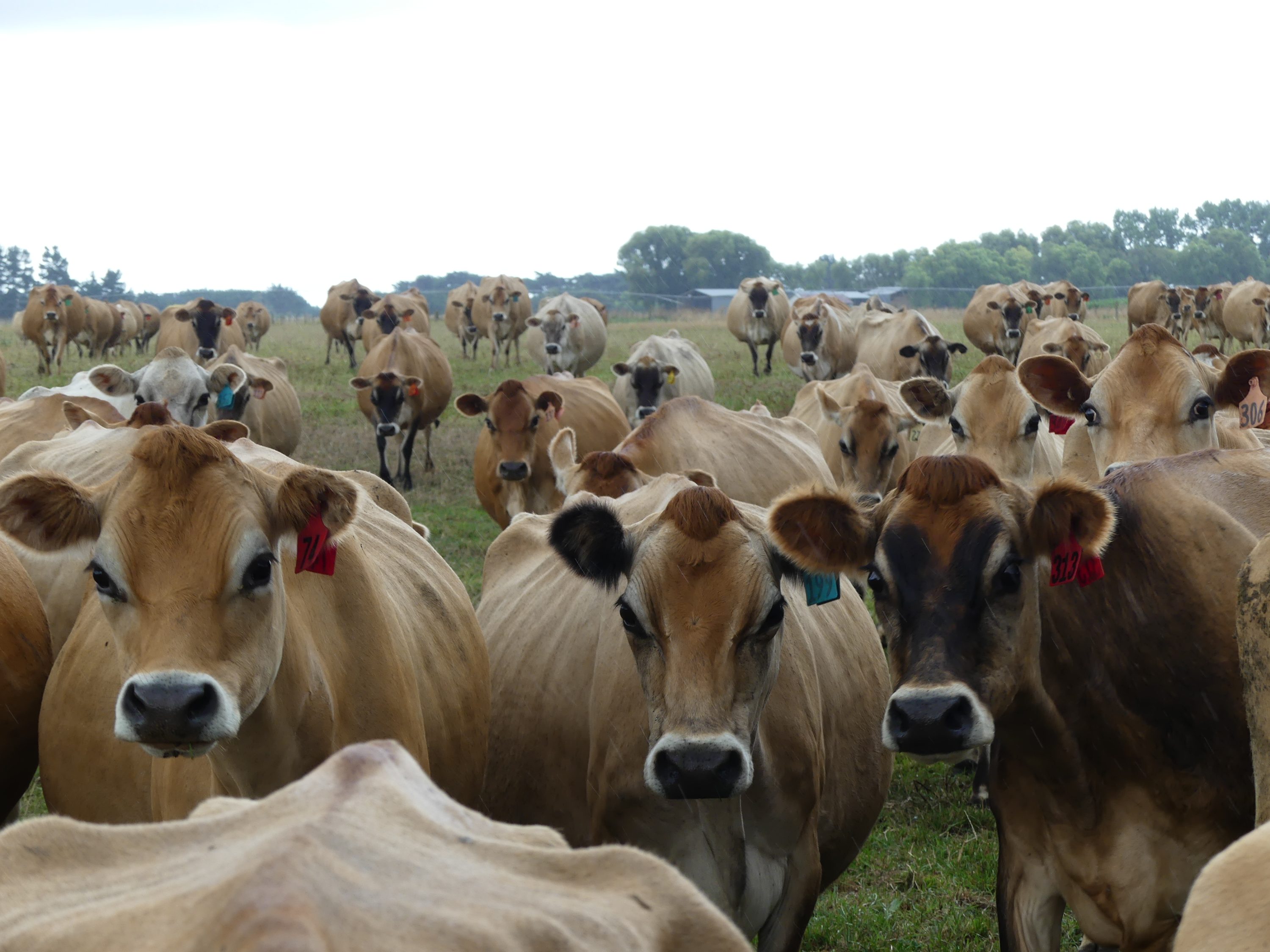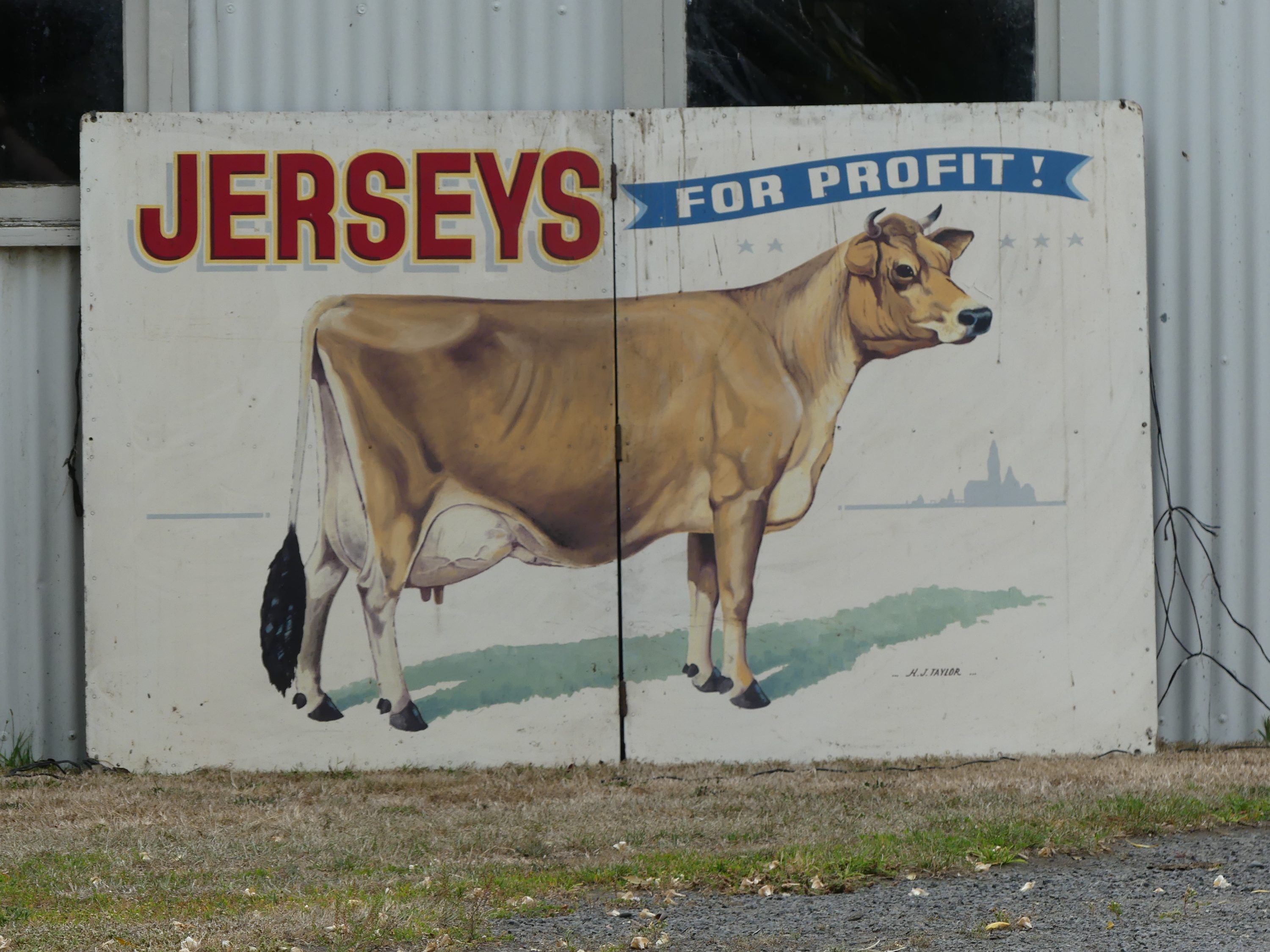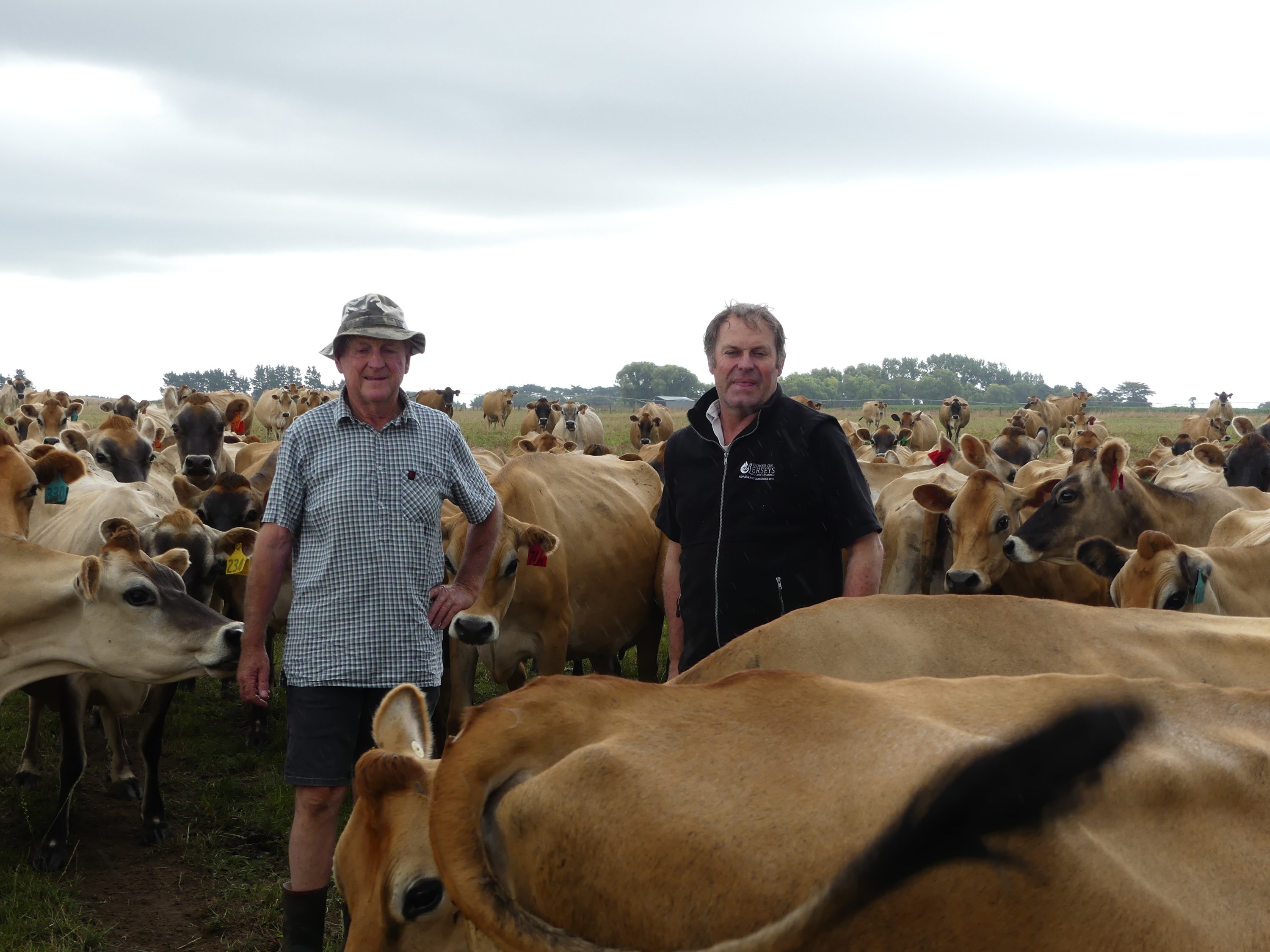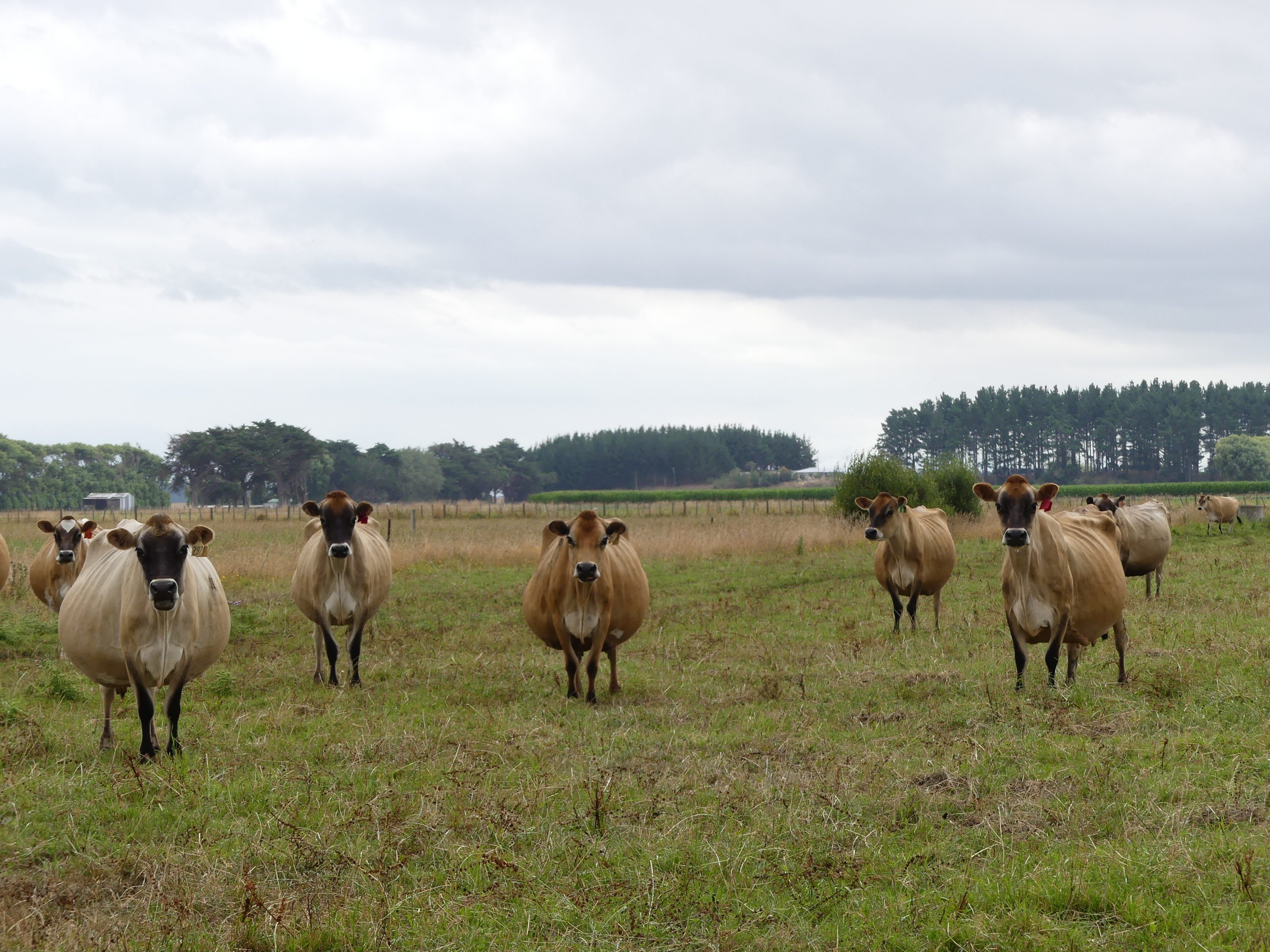Kaimatarau Jerseys – delivering high-performance results
Pam Goodin, JerseyNZ
Kaimatarau Jerseys, nestled just outside Rongotea, is proving that performance keeps this family loyal to the Jersey Breed. While the Pedley family’s legacy in dairying spans more than a century, it’s the herd’s exceptional genetic merit and productivity that set them apart today. With a focus on high index genetics, Lindsay Pedley has grown the Kaimatarau herd into one of the top genetic merit herds in the country, consistently outperforming many of the region’s Holstein Friesian herds on a per-cow basis – and without the added infrastructure. Their cows are delivering impressive milksolids totals season after season, and the results are speaking louder than tradition ever could.
Honorary Life Members of JerseyNZ, Maurice and Lorraine need no introduction in the Jersey community, with Maurice serving on the JerseyNZ Council from 1997-2005 and as President from 2000-2004. They now farm in conjunction with son Lindsay and his wife Claire. This land has been farmed by the Pedley family since 1910, originally by Maurice’s grandparents. His father carried on, first leasing the farm for 20 years and then purchasing the 35 ha farm in 1943. He bought his first pedigree Jersey in 1932 at the local Rongotea saleyards. The family then moved to pedigree Jerseys, and there is still a descendant in the herd from among the first cows.
Maurice went into partnership with his father in 1974, trading as AS & MA Pedley, after buying into the herd first. In 1977 they purchased an additional block on State Highway 1, that the original block backs on to. The herd is named Kaimatarau Jerseys after the side road where the original land is. His father passed away in 1989 and in 2007 Maurice and Lorraine set up the current company Carnarvon Farms Ltd with son Lindsay as an equity shareholder. That setup remains in place today, although Maurice & Lorraine are starting to look at bowing out. Succession planning is underway involving all four children, and Lindsay hopes to be able to take over the farm.
More land was purchased in 2007 and again in 2018, with the property now totaling around 160 ha. The farm is flat with sand dunes running through. A 40 ha support block is leased directly across the road, with another 80 ha support block also leased at Foxton.
Maurice and Lorraine married in 1972 when she was just 19, a real townie girl who quickly adapted to loving farm life. In the early days they milked the herd of 100 on their own without any labour. These days Lindsay makes all the major decisions. Maurice and Lorraine rear the calves, and Maurice helps out with milking. All three can turn their hand to any job on farm, but Lorraine draws the line at driving the big tractors! They have assistance from a full-time 2IC. Maurice and Lorraine are starting to take a step back from the day-to-day and plan on being less active on farm moving forward. To that end they are currently working on on-farm accommodation to be able to employ an extra labour unit.
Eldest son Andrew owns a contracting business based on the farm and of course he does all contracting work for the farm; he and his wife have five children. Tony is a truck salesman living in Palmerston North with his wife; Lindsay and Claire live on the farm with their two children; and youngest Anna lives in Palmerston North with her two children.
The family is currently milking 376 cows, having calved down 400. This is the most they have ever calved, having been slowly increasing herd numbers as they have added land. They believe they have reached peak cow numbers for the farm now.
The support blocks are home to the calves, plus about 100 beef animals, about half of which are Jersey/Angus cross out of the dairy herd. The balance are bought in and all are reared through to the works at around two years. Most of the grass-based supplement is also grown on the support blocks. The effective milking area on the main farm is 135 ha, the balance is not suitable for dairy and instead is used for beef and bulls.

When visited in late January they needed rain, having had no rainfall to speak of since before Christmas. This is sandy country, so they do expect to be summer dry and the area is looking pretty brown. Average rainfall is 1000 mm per annum, but it has fallen well short of that for the past two seasons. They bought in 100 tonnes of maize silage as autumn feed, and grow 1300 bales of silage per annum. This is used throughout the year as needed, with up to 8 bales fed per day in the summer. The in-shed feed system feeds 3kg per day throughout the season of 60% PK blend with DDG, soy bean whole pellets and biscuit meal, The blend also includes standard minerals, and from Christmas onwards zinc is added.
The shed is a 24-aside herringbone built in 2004 when they were milking 200 cows. These days they struggle to get all of the herd in the yard at once and will milk up to 17 rows during the peak over 2.5 hours per milking including cleanup. The herd is milked twice a day usually until 1 March, or if they drop below 1.4 kg, when they will drop to once a day. Early February is the earliest that they have dropped back. Calving starts in early July; they like to get as many in as possible before the dry starts. All stock are wintered on farm.
The last three seasons have been good to them, with an average of 480 milksolids per cow in 2022/23 and 462 kg ms in the 2023/24 season. This season they are on track to finish at the mid point between these two results. This is above average for the region. Their goal is to crack the magic 500 kg milksolids average. To do that they will need more rain at the right time, and it could also prove difficult without a mixing wagon and the extra costs that entails. However, they are rightfully proud of a herd producing 110-120% of their liveweight. The herd also produces well right from two-year-olds, so if they do leave the herd early there isn’t any loss in production.
AB mating starts on 1 October, and all matings are done by Lindsay who has been an LIC AI tech since he was 16 – that’s 30 years now. He still has an AB run, which will continue as long as Maurice and Lorraine are still active on the farm. The heifers are synchronised and AB mated in the first few days of mating.
Maurice has come from a traditional breeding background, that included showing alongside his father. As he became more involved with breeding, he started to tinker with AB bulls and the first he used was Glanton Red Dante. He got some interesting results production-wise and the AB bulls were certainly superior to the some of the bulls they had been using and as a result he started chasing genetic gain via artificial breeding. Lindsay in turn is very keen on high index genetics and has grown the herd to one of the higher genetic merit herds in the country. This has certainly benefited production too.
Conformation is important to the family. There is an old saying to ‘breed a cow for production and get used to what she looks like’. But AB companies today are placing more emphasis on conformation in bull selection than they have in the past, and TOP inspection for conformation certainly changed the game.
In terms of bull selection, Lindsay now makes all the breeding decisions and trusts the animal evaluation system. He relies on BW first, then moving into individual breeding values, looking across the board at the offerings of all AB companies. They were early users of genomic bulls, and Lindsay won’t consider any bull below a certain BW level, regardless of conformation BVs. He is also likely to take a chance on the odd high BW bull with low reliability or not ideal BVs, just in lower straw numbers. The bottom 20% of the herd is mated to Angus.
This season they have 40 contract mated cows, all to LIC. They have also had the odd contract with CRV, but tend to find the two companies are chasing the same cows. They have flushed two heifers this season, one through the LIC Generate programme, and currently have 19 embryos in cows.

They will use semen from at least six bulls in the herd this mating season, sometimes Bull of the Day, but mostly nominated. They have used Jersey Future in the past and intend to nominate more young bulls for genetic gain programmes. Having tried overseas genetics in the past without success in terms of their breeding philosophy, they now use all New Zealand genetics. Having said that, Maurice feels that the third generation after the use of an overseas bull is where the real benefit comes, and they will consider changing if inbreeding becomes an issue.

Come October every year, Lindsay could sell twice as many surplus calves at 4-7 days old than he can supply. Mostly these will be sold locally or to Dannevirke for rearing and reselling. They retain all females born on the farm and always have a market for any surplus yearlings and in-calf heifers too if they have not been needed as the herd size increases. Lindsay comments that the herd is producing more per cow than most of the local Holstein-Friesian herds, even those with feedpads and extra infrastructure. While he has only ever known Jerseys, it is not the family tradition that is keeping him in the Jersey fold, but their performance. He also prefers a pure breed to a crossbreed.
The herd is fully registered and all two-year-olds along with 10-12 four-year-olds are TOP classified annually. Maurice is proud that they could still pull a show team from the herd if they were so inclined. While they are no longer showing themselves, two of the Powell sisters (Radly Holsteins) took a high index cow home and broke her in for the Horowhenua Royal Show in 2024. Kaimatarau General Jewel went on to be awarded Senior Jesey Champion and Senior All Breeds Champion. The girls then made up a fabulous board for Maurice & Lorraine with her ribbons and medals.
The family have long been supporters of the local Jersey Club but note that as with many clubs there is less involvement from members with the way that modern technology and social media has changed, especially for younger breeders. Maurice was a TOP Inspector for over 30 years, as was his father as a Classifier before him spanning both the original and more modern systems. Also a long-time Judge, a highlight was judging the Royal Show at Christchurch on the old grounds, and he has also been a Judge in the Semex On Farm Challenge. He has attended many JerseyNZ Annual Conferences over the years and has a long time involvement with the Manawatu A & P Association and is a past-President of that organisation.
Off farm, the local rural community has played a large part in their lives. Maurice has been involved with local school Committees, Young Farmers and church activities. He and Lorraine also have a holiday home an hour away at Pekapeka (near Waikenae on the Kapiti Coast), used as a getaway spot by the whole family. As they start to ease back from the farm, they expect to spend more time at Pekapeka, and while they contemplate enjoying a well-earned retirement, they will not lose the link with the farm. Lindsay is on the local Rugby Club committee, plays squash regularly, and chases his children (14 & 16). His wife Claire is the General Manager of a local law firm and involved with the Chamber of Commerce.

Their biggest success has been the growth of the farm and business as a family in the last 15 years – doubling in size, and all through their own hard work. For now, the farm system is working for them and so there are no changes planned. They like being in a position to face changes and adapt. Lindsay doesn’t expect that his children will be farmers, but he is not ruling out other family involvement in the future. His aim is to get the farm to the point where it can one day be operated by a Contract Milker.
The family is rightfully proud of where the Jersey cow has taken them, for Maurice and Lorraine that includes visits and Jersey friends around the world. Lindsay comments that most of his friends think that he is crazy to stick to Jerseys, but he has no intention of changing breeds. This herd is in a great position on State Highway 1, and it is not uncommon to have people stop for photo opportunities, sometimes even asking to see the cows milking. They are very proud to carry on promoting the Jersey breed in their own quiet way.
